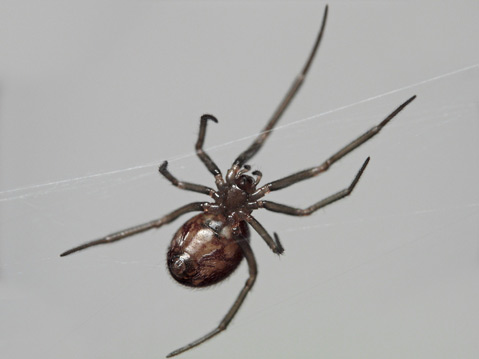Spider Senses
Arachnids Are Among the Front Line of Garden Friends

In fall, there are the giant orb weavers with their striped and ornamented bodies. They hang in the middle of large circular webs of classic shape. These are the females, fattening up to attract a male and lay their eggs. Daddy longlegs lurk in the corners of our ceilings, eating who knows what (some evidence points to mostly each other). Little wolf spiders, with their fuzzy red backs, leap about adventurously to ambush their prey. Many spiders hide most of the day, while constructing their sticky traps by night. Which species is it that can waft a few threads across the doorstep or pathway just at face level overnight? Repeatedly!? Spiders are everywhere, and, as good gardeners know, they can be a boon in the fight against plant pests.
There are an estimated 36,000 known species of spiders worldwide, and some scientists (arachnologists, to be specific) believe that may be only the half of it. They are carnivores and generalist predators that will eat almost any insect or small arthropod. Many humans have an intrinsic fear of or loathing toward spiders, but think twice about killing them. There are only four species of spiders in the U.S. that are poisonous, and only one of those lives in the Santa Barbara area: the black widow spider. Its distinctive shape, color, and markings make it easy to identify and eradicate.
Spiders are actually among the front line of garden friends. While the weavers are capable of capturing flying insects, they often feast on some of the other beneficial flies and lacewings that could also be useful garden predators, so they are a mixed blessing. The lurking — or wandering, as some scientists characterize them — spiders are the real heroes. These crab spiders, jumping spiders, and wolf spiders do not build webs but scurry through the garden snacking on a wide variety of insects, including some of the worst pests such as aphids. One study that included spiders in an enclosure with broccoli plants infested with pests found a reduction of more than 60 percent in the pest populations as compared with a similar plot without spiders.
To enlist more spiders in the garden, provide habitat not only for the spiders but also for their prey. Mulching provides hiding places for the lurking types and maintains a more even level of humidity. Planting flowering plants and shrubs will attract the insects that spiders prey on and give the weavers a scaffold to hang their webs from. Do not use pesticides; spiders are not pests. For an illustrated guide to the spiders common in the area, check out these University of California Garden Spider website here and here.
Conquer the fear, and, if necessary, carry a stick to clear away those webs that cross your path. They may be back again tomorrow, but at least they are evidence that the spider corps is busy keeping the insect population in check.
April Tips
• If you didn’t get roses planted during the bare-root season, many have been potted up and are bursting with growth; they’re a little more expensive, but no time has been lost.
• Plants are alive with tender new growth, so pests are arriving. Wash off aphids with water, and bait for snails with iron phosphate granules (Sluggo is one brand name).
• Start warm-season veggies like tomatoes, peppers, squash, and cucumbers and annual flowers like zinnia, petunia, ageratum, cosmos, and marigold.
• Call the Theodore Payne Foundation Wildflower Hotline to find out where the best show is each week: (818) 768-3533.



